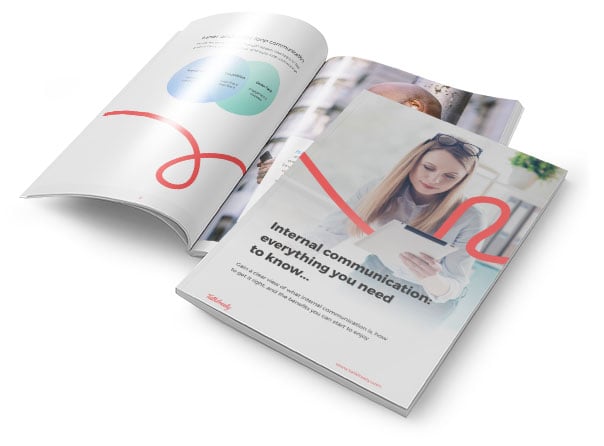So, what is employee engagement? The definition of employee engagement is a complex issue. There is no simple answer. Employee engagement isn’t just a one-size-fits-all blueprint. It’s a formula that needs to be adapted and personalised to suit the unique needs of your organisation.
Employee engagement is far more complicated than simply ensuring your employees are happy and satisfied. Happiness is definitely part of the formula, but there are many other elements to consider as well. For example, a happy employee can cheerfully turn up to work and get on with the tasks of their job but still put no extra effort into their role or care about the company's overall success. You need your employees to feel an emotional commitment to the business and its goals. This is one of the key drivers of employee engagement.
In addition, every business will have different requirements from their employees. Some may be going through a period of rapid growth and need staff to feel motivated and involved in the change taking place around them. Others may have multiple teams working across the organisation and require a close understanding and cooperation between these disparate sets of employees. New hybrid ways of working have brought additional challenges and complexities to consider.
In this blog, we take a deep dive into the definition of employee engagement and explore some of the key employee engagement definitions that have been proposed. We then consider practical ways to improve employee engagement across your workforce. Build some of these into your internal communications strategy, and you’ll see an immediate upturn in engagement levels.
What is employee engagement, and why is it important?
Employee engagement is a term most business leaders are familiar with, but one which is remarkably difficult to define. Almost every article, organisation or individual has a slightly different angle on the definition of employee engagement, and employee engagement trends have differed over time. And from inconsistency comes confusion not only about what employee engagement is but also what businesses expect it to deliver in practice.
Considering that employee engagement initiatives are often essential to producing a motivated, focused workforce, getting to grips with this concept is vital for boosting your business to the next level.
Definition of employee engagement: 7 versions to consider
What is the definition of employee engagement? Well, it depends who you ask. We’ve pulled together seven of the best employee engagement definition by authors across the industry. Read through and see which one resonates with you and your organisation.
#1 Original: Kahn 1990 employee engagement definition
Let’s start at the very beginning. In 1990, at the birth of the notion, academic William Kahn defined the employee engagement meaning as:
“The harnessing of organisation members’ selves to their work roles”
In essence, Kahn appears to be defining a clear link between the employee's role and their personal perception of self. Harnessing or achieving this link was a perfect opportunity for businesses to generate improved employee engagement. However, the best methods for achieving this remained a little more ambiguous, and this remains one of the core dimensions of employee engagement.
#2 ‘Well-being’: employee engagement Gallup definition
The next attempt to conquer the idea came from a big player in the world of business stats: Gallup. The employee engagement Gallup definition is one of the most highly rated versions. According to Gallup, engaged employees were considered:
“Those who are involved in, enthusiastic about and committed to their work and workplace. Gallup categorises workers as "engaged" based on their responses to key workplace elements it has found (to) predict important organizational performance outcomes.”
The three core elements that make up this staff engagement definition are that employees should be involved, enthusiastic and committed. This builds on the initial definition purported by Kahn and offers more tangible ideas to help employers engage their teams. In addition to proposing a definition for employee engagement, Gallup has also worked to define ‘well-being’ in the broader sense, a concept which is important in the workplace. The results state that there are five essential elements of well-being which need to be met:
- Social - having supportive relationships
- Purpose - liking what you do each day and finding motivation to achieve your goals
- Financial - managing your economic life in order to increase security and reduce stress
- Community - feeling safe and having a sense of pride in your community
- Physical - having good health and enough energy to get things done
Though the results can be applied to any area of life, they become particularly interesting when you apply them to Gallup’s ideas regarding employee engagement theory. By implementing these ideas into the working space, Gallup seems to be implying, you can increase employee engagement across your team, offering extensive benefits for all parties involved.
#3 ‘Extra mile’: employment relations definition
According to Gallup, these notions of involvement, enthusiasm and commitment are central to engagement. This is a viewpoint that many commentators would agree with, including Professor John Purcell. As a leading authority on people management and employment relations, and academic adviser to ACAS, he knows a thing or two about engagement. He expands Gallup’s idea with his employee engagement meaning, stating that:
“Engagement is a combination of attitude and behaviour. The attitude is ‘commitment’, and the behaviour is ‘going the extra mile’”
It’s interesting how Purcell adds an extra dimension to the theory by suggesting engaged employees ‘go the extra mile’. This seems to be referring to the importance of employee advocacy, and is an action that combines both an enthusiasm for the work and a commitment to getting the job done, both of which are significant bonuses to both employee and employer.
4. ‘Workplace’: employer responsibility definition
A major milestone in the establishment of employee engagement in mainstream business thinking was the 2009 MacLeod Report ‘Engaging for Success: Enhancing performance through employee engagement’.
In this report, MacLeod and Clarke place responsibility for improving engagement on the shoulders of employers, seemingly suggesting that it is the responsibility of the workplace to ensure that this ideal atmosphere is curated and maintained. Once these guidelines are in place, they seem to say the engagement will follow as a natural next step. In the report, they define employee engagement as follows:
“A workplace approach designed to ensure that employees are committed to their organisation’s goals and values, motivated to contribute to organisational success, and are able at the same time to enhance their own sense of well-being.”
Once again, MacLeod is placing responsibility on the employer to boost engagement, adjusting the existing definition to a more leader-centric employee engagement model. He also appears to be suggesting that encouraging employee engagement benefits both employee and employer. The employer will enjoy a more motivated, productive workforce, with every team member working and striving towards a common goal. On the other hand, the employee enjoys a boosted sense of well-being, a notion of purpose, and a feeling that they are part of a greater communal goal.
#5. ‘Feel good’: employee experience definition
There has been a great deal of observation on the definition of employee engagement, much of which has placed the emphasis has been on what the employee must do and less on why they should do it. Just why is employee engagement important? Can it really offer substantial benefits to your business? Jacob Morgan, author of The Employee Experience Advantage, seems to believe so. He says in an article for the Harvard Business Review:
“When organisations make real gains, it’s because they’re thinking longer-term. They’re going beyond what engagement scores are telling them to do in the moment and redesigning employee experience, creating a place where people want, not just need, to work each day.”
#6. ‘Personal’: employee engagement definition
If you have any doubt about whether your colleagues share your definition of employee engagement, just ask them: “What is employee engagement?” Chances are high that there will be no single, unifying response.
This proved true when we tried asking for a simple definition of employee engagement from our colleagues. Two fascinating responses stood out for us. A highly respected HR Director (admittedly put on the spot in a classic ‘ten seconds in a lift’ moment) suggested:
“Employee engagement is the permanent on-going conversation with every employee, and their actions and behaviours.”
As one might expect for an HR Director at the top of her game, her focus was on the conversation. What is employee engagement in HR is all about communication. This is why HR departments are particularly strong advocates of the employee engagement platform, with its powerful, multi-channel capabilities.
In contrast, an experienced engineer at a major utilities company believed it was about his behaviours and attitudes, with the emphasis on him as an employee to do the engaging. It is clear that any employee engagement initiatives need to consider varying personal viewpoints.
#7. ‘Probably the best’: definition of employee engagement
Of all the employee engagement definitions, this simple statement from David MacLeod is probably the best:
“(Employee engagement) is about how we create the conditions in which employees offer more of their capability and potential.”
This definition for employee engagement is so important because it puts the onus fair and square on the employer to create the right environment, not the employee to do all the legwork. This shift of responsibility requires an employer to promote, develop and sustain engagement, not just instigate it. This is at the heart of employee engagement theory.
It is perhaps this misunderstanding of engagement as an employee-led process that is causing so many employees to be disengaged for so much of their working lives. Altering the paradigm to place the responsibility on the shoulders of employers as opposed to employees can have transformative results. Crucially, it shows the impact of strong leadership. Employee engagement and leadership are inextricably linked.
In conclusion: the definition of employee engagement
Now, when you’re asked, “what is employee engagement?” you’ll have a wealth of definitions to draw on. Ultimately, you need to develop your own personal definition of employee engagement based on the specific needs of your organisation and the challenges it is currently facing. Employee engagement is a complex topic that requires a personalised, targeted approach.










